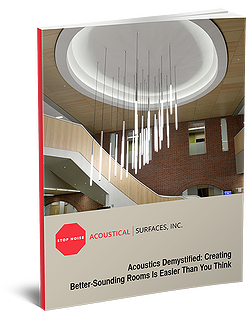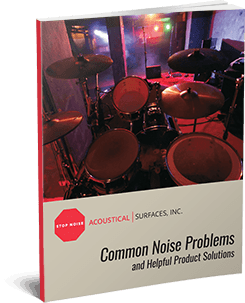Planning for Vibrational Noise During Architectural Planning
Vibrational noise control is an often overlooked element in the early stages of architectural planning. While seasoned urban designers may recognize its significance in multi-unit or high-density developments, it’s a critical consideration for all types of buildings. Addressing vibrational noise from the outset can prevent costly retrofits, protect sensitive equipment, and enhance occupant comfort and well-being.
While soundproofing often gets the bulk of the attention, vibrational noise is an important but not as obvious challenge that can have just as big an impact, especially if it’s ignored during the early stages of design. This article breaks down what vibrational noise is, why it matters across different types of spaces, and how thoughtful planning, including the use of vibration isolation solutions, can help you avoid issues before they start.
What is Vibrational Noise and Where Does It Come From?
Nearly everyone living in modern, populated areas has experienced vibrational noise. Whether it’s the subtle hum of a pump or other water based system, the distant rumble of a train, or the subtle impact on your ears from a rooftop air conditioner Unlike airborne sound, which travels through the air and can often be blocked with conventional acoustic treatments, vibrational noise is a form of structure-borne sound energy. It travels through the physical components of a building, including walls, floors, ceilings, and even foundations.
Vibrational noise is created when mechanical energy, often from repetitive mechanical movement, is transferred directly into a structure. This energy then propagates through the building materials, potentially reaching spaces far from the source and affecting the comfort and functionality of otherwise quiet areas.
Common sources of vibrational noise include:
- HVAC vibration from large or poorly isolated equipment
- Elevator machinery and shafts
- Mechanical room noise, especially when equipment is located adjacent to occupied or sensitive spaces
- External factors such as nearby rail lines, subway, or industrial centers, which may require specific industrial vibration management strategies
Because structure-borne noise bypasses traditional barriers, it’s more complex to control after construction is complete. That’s why identifying sources of vibrational noise and accounting for pathways early in the design phase is essential for long-term performance and occupant satisfaction.
Why Vibrational Noise Control Needs to be Addressed in Early Planning Stages
Noise and vibration mitigation is not just an acoustic issue, but one that has structural and economic impacts as well. The most effective and cost-efficient time to address vibration issues is during the early design phase, when layout decisions, material selections, and isolation strategies can be seamlessly integrated into the building plan.
Vibration mitigation becomes significantly more challenging once construction is complete. Retrofitting typically involves dismantling structures and assemblies for access, meaning they are not only expensive, but may considerably disrupt home or work life for extended periods.
There may also be structural implications to consider. Vibrational energy can interact with a building’s natural resonance frequencies, leading to unintended amplification and more widespread transmission of noise through floors, walls, and supports. Addressing vibrations early, with solutions like wall isolation clips, prevents them from affecting the building in unpredictable ways.
Lastly, early planning is critical in sensitive environments, where vibration control directly affects the functionality and safety of the space. Some examples include:
- In hospitals, excess vibration can interfere with imaging equipment and patient recovery.
- In research laboratories, it can compromise the accuracy of sensitive instruments.
- In recording studios, even subtle vibrations can degrade sound quality and make accurate monitoring difficult.
- In educational facilities, it can negatively impact concentration, speech intelligibility, and overall learning environments.
- In multi-unit structures like condos or hotels, when multiple or large mechanical equipment or pumps are required to deliver air or water throughout a building, it can affect concentration, sleep and overall wellbeing.
Incorporating vibrational noise considerations into early noise control planning ensures that the building performs as intended, protects its users, and avoids costly problems down the road.
Key Areas Where Vibrational Noise Control is Critical
Not all types of buildings face the same challenges when it comes to vibrational noise. Certain areas demand advanced planning to ensure vibrations don’t negatively impact comfort, function, or performance. Here are some key areas where addressing vibrational noise early on can make a lasting impact.
Mechanical Rooms and Equipment Pads
Mechanical rooms often generate continuous vibrational energy from the operation of systems such as HVAC units, pumps, and chillers. These vibrations can propagate through structural components to reach areas far from the source. In buildings with lightweight framing or open structural paths, this often leads to persistent low-frequency noise, which can be distracting or disruptive to both people and sensitive operations.
Multifamily and Mixed-Use Developments
In multifamily and mixed-use developments, vibrational noise often originates from everyday activities like running appliances or using the elevator. These vibrations can travel through floors and walls, making noise in one unit travel to other units in ways we can both hear and feel. Evaluating assemblies for their STC and IIC ratings during the design phase helps ensure adequate performance against both airborne and impact noise.
Medical and Research Facilities
Hospitals, laboratories, and research facilities all house equipment and operations that demand extremely stable conditions. In these environments, even the most minor vibrations can interfere with sensitive instruments, distort imaging results, or disrupt surgical precision. Microscope labs and MRI suites, for example, require consistently low-vibration conditions to function accurately, often guided by established lab vibration standards. Any deviation–no matter how minor–can affect diagnostics, research quality, or patient outcomes.
Recording Studios and Performance Spaces
In environments where audio quality is critical, structural vibrations can be especially problematic. Low-frequency vibrations from nearby activity or mechanical systems can enter the space and compromise recording clarity, introduce unwanted noise, or interfere with live recording and monitoring. We may not always hear these vibrations with our ears, but they can be felt or picked up by sensitive microphones, leading to degraded sound fidelity and reduced acoustic control.
Solutions for Vibrational Noise Control
Once we have identified potential sources of vibrational noise during the planning phase, the next step is to select the appropriate methods to control those vibrations. Acoustical Surfaces offers a range of specially engineered solutions designed to interrupt or absorb the transmission of structure-borne sound. Each type of solution addresses specific sources, frequencies, and structural elements. Selecting the right combination depends on the unique space you’re working on.
Isolation Mounts and Spring Hangers
Isolation mounts, resilient mounts, and spring hangers are designed to absorb mechanical vibrations at the source, particularly those created by heavy or suspended equipment. These devices work by decoupling vibrating machinery such as HVAC units, ceiling fans, and ductwork from the structural frame, significantly reducing the amount of vibration transferred into ceilings or walls. They are especially effective in spaces like mechanical rooms, utility corridors, and any area with suspended or rotating equipment.

IMF Simple Spring Mount
Floating Floors and Underlayments
Floating floor systems and floor underlayments are key solutions for reducing impact-borne vibration, such as footfall noise. These systems create separation between the walking surface and the structure below, absorbing and dampening vibrational energy before it spreads throughout the building. They are especially important in multi-level residential and commercial buildings, as well as in performance spaces and recording studios where impact noise can directly interfere with the finished product.
Wall and Ceiling Isolation Clips
Wall and ceiling isolation clips break the physical connection between framing members and finished surfaces (drywall), preventing vibrational energy from transferring between structural elements. These clips help isolate rooms from shared walls, ceilings, and mechanical systems. Acoustical Surfaces recommends the use of the RSIC-1 clips, a proven solution designed to provide excellent isolation in both residential and commercial applications. These clips are often used on both walls and ceilings in home theaters, home offices, bedrooms, classrooms, workout facilities, hotel rooms, conference rooms, and condo or apartment units where privacy is a priority.

RSIC-1 clip in a furring channel
Vibration Damping Materials and Barriers
Damping materials (viscoelastic compounds) like Green Glue are used to reduce structural resonance and minimize the transmission of vibrations through walls, floors, and ceilings. The Green Glue plus the second layer of drywall not only adds mass and density, but the vibration dampening compound will absorb energy and convert the non-wanted energy into a very small amount of heat.
Read More: How Does Green Glue Soundproofing Work?
Product Comparison Table
To help determine which solutions work best for your project, the following table provides a generational comparison of vibrational noise control products:
| Product Type | Use Cases | Effective Frequency Range | Common Installation Locations |
| Isolation Mounts & Spring Hangers | HVAC, fans, pumps | Low to mid frequencies | Mechanical rooms, ceilings |
| Floating Floors & Underlayments | Foot traffic and other impact noises | Mid to high frequencies | Studios, multi-level housing, gyms |
| Wall & Ceiling Isolation Clips | Inter-room noise, mechanical vibration | Mid frequencies | Home theaters, apartments, offices |
| Damping Compounds | Structural resonance, low-frequency control | Mid frequencies | Wall cavities, floors, ceilings |
Best Practices for Architects and Engineers
Integrating building vibration control into your building acoustics design doesn’t need to be complex, but it does require some planning. By incorporating key practices early in the planning process, architects and engineers can avoid costly retrofitting and ensure better long-term performance. Here are some best practices to help you address vibrational noise from the outset:
Collaborate with an Acoustical Consultant During Design Phase
Early coordination helps identify potential problem areas and ensures that isolation strategies are integrated into planning decisions and not added as an afterthought.
Include Vibration Isolation Specifications in Mechanical Plans
Ensure that all equipment mounting and structural support details include clear vibration isolation requirements such as vibration isolation pads or mounts to prevent unintentional transfer into occupied spaces.
Conduct Vibration Analysis for Sensitive Equipment Zones
For areas like labs, imaging suites, or studios, baseline vibration studies can guide design criteria and equipment selection based on your actual site conditions.
Specify Materials with Known STC/IIC and Vibration Damping Ratings
Selecting products with proven acoustic performance and vibration dampening properties such as those designed for ceiling decoupling helps avoid guesswork and ensures that assemblies meet or exceed project goals for noise and vibration control.
Partner with Acoustical Surfaces for Expert Vibrational Noise Control
Vibrational noise control is most effective when it’s planned from the ground up and having the right partner can make all the difference. Acoustical Surfaces is a trusted resource for architects, engineers, and facility designers looking for reliable solutions that perform.
With a wide range of tested and proven products, we offer everything from isolation mounts and underlayments to damping materials and structural barriers. Our team can provide the expert guidance you need to help select the right solutions for your project’s unique demands, including assistance with specifications and application strategies.
Whether you’re designing a hospital, home recording studio, or high-rise residential building, Acoustical Surfaces offers custom solutions tailored to complex vibrational noise challenges. With over 35 years of experience supporting design professionals across various industries, we’re committed to helping you build spaces that are quieter, more comfortable, and acoustically resilient.








